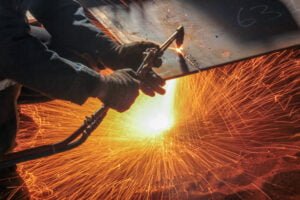
In today’s competitive world, businesses are constantly seeking innovative solutions to enhance their productivity and efficiency. When it comes to laser cutting and laser welding processes, the utilisation of PSA nitrogen has emerged as a game-changer. In this article, we will delve into the benefits and applications of PSA nitrogen for laser cutting and laser welding, providing you with valuable insights that can help your business thrive in these fields.
Table of Contents
Understanding PSA Nitrogen
PSA, or Pressure Swing Adsorption, is a technology widely employed to generate high-purity nitrogen gas. PSA nitrogen refers to the nitrogen produced through this method, which is characterised by its purity, reliability, and cost-effectiveness. By utilising a carbon molecular sieve, PSA nitrogen generators selectively adsorb oxygen and other impurities from the air, leaving behind pure nitrogen gas.
The Advantages of PSA Nitrogen for Laser Cutting
- Laser cutting is a precise and efficient method used across various industries, including automotive, aerospace, and electronics. PSA nitrogen offers numerous advantages that can significantly enhance the laser cutting process:
- Enhanced Cut Quality: Nitrogen acts as a shielding gas during laser cutting, preventing oxidation and ensuring a clean, high-quality cut. The use of PSA nitrogen eliminates the risk of contamination, leading to sharper and more precise edges.
- Minimised Oxidation: Oxygen, when present during laser cutting, can cause oxidation on the cut surface, leading to undesirable results. PSA nitrogen displaces oxygen, reducing oxidation and resulting in superior cut finishes.
- Reduced Heat-Affected Zone (HAZ): PSA nitrogen helps minimise the heat transfer during laser cutting, reducing the size of the heat-affected zone. This leads to less distortion and improved overall part quality.
- Increased Cutting Speed: By utilising PSA nitrogen, laser cutting processes can be optimised to achieve higher cutting speeds. This not only improves efficiency but also reduces production time, enabling businesses to meet tight deadlines.
- Versatility: PSA nitrogen can be used with a wide range of materials, including steel, aluminium, stainless steel, and various alloys. Its compatibility makes it a versatile option for different laser cutting applications.
The Benefits of PSA Nitrogen for Laser Welding
- Laser welding is a crucial process in industries such as automotive manufacturing, aerospace engineering, and medical device production. The utilisation of PSA nitrogen can greatly enhance the laser welding process, offering several notable benefits:
- Improved Weld Quality: PSA nitrogen acts as a shielding gas during laser welding, reducing the formation of unwanted oxides and nitrides. This leads to superior weld quality, with minimal defects and improved mechanical properties.
- Reduced Spatter: Spatter, the ejection of molten metal particles during welding, can negatively affect weld quality and necessitate post-weld cleaning. PSA nitrogen minimises spatter formation, resulting in cleaner welds and reducing the need for additional cleanup steps.
- Enhanced Process Stability: PSA nitrogen provides a stable and consistent environment during laser welding. Its controlled atmosphere ensures uniform weld penetration, reduced porosity, and improved overall process stability.
- Increased Welding Speed: By utilising PSA nitrogen, laser welding processes can be optimised for higher speeds. This leads to increased productivity, shorter production cycles, and improved cost-efficiency for businesses.
- Welding of Reactive Materials: Certain materials, such as titanium and some stainless steels, are highly reactive and prone to oxidation during welding. PSA nitrogen eliminates the presence of oxygen, enabling the successful welding of these challenging materials.
Conclusion
PSA nitrogen has proven to be a valuable asset in the fields of laser cutting and laser welding. Its ability to enhance cut quality, reduce oxidation, minimise heat

